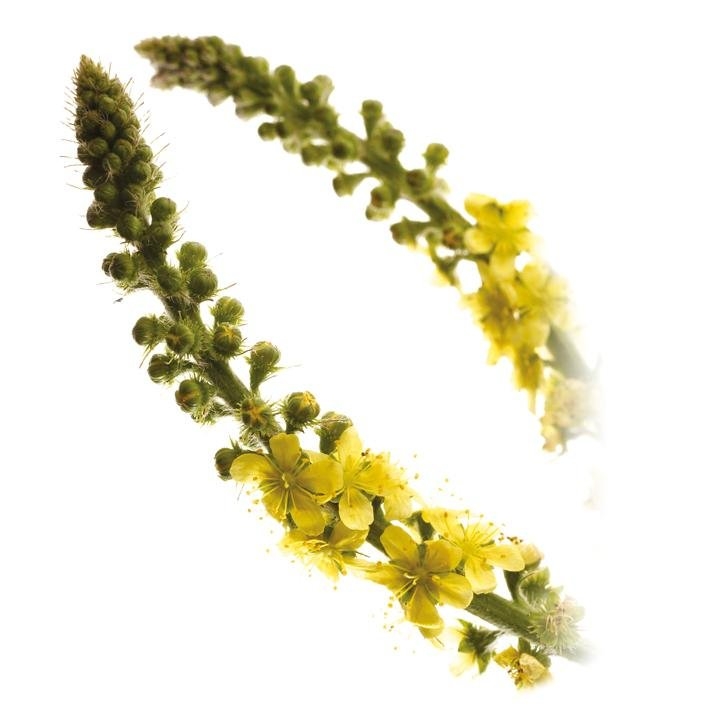Description
Herbaceous plant, upright, 30-60 cm high, short root. The stem is simple and mostly unbranched, reddish with numerous soft hairs. Big pinnatisect, alternate, sessile leaves that show 5-9 oval-lanceolate segments deeply toothed with hairy and whitish underside intermixed with smaller segments; violet stipules. Leaflets grow around 2-3 cm long, with a toothed edge. Bright yellow color flowers arranged closely on slender, terminal spikes (elongated terminal bunches) slightly notched at the end. They are 5 to 8 mm in size, with the calyx pointing downwards, star-shaped. The grooved ovary has protruding small uncini. The fruit is an achene enclosed in a receptacle of around 6 mm, obconic and deeply grooved, hairy, crested at the uppermost side. Agrimony belongs to the Rosaceae.
Originated in Asia, north of Africa, Europe and North America. Found on bank, open woods, field sides, waste ground and dry thickets, has preference for fresh and shadowy places. Blooms in May and should be harvested while it is blooming.
Part used
Leaves and flowering tops.
Indications
Internal use:
- Non-specific acute diarrhea; chronic diarrhea in children. If diarrhea persists, agrimony should not be used for a period longer than 3 or 4 days without a doctor’s prescription.
- Respiratory disorders: pharyngitis, laryngitis, tonsillitis, hoarseness.
- People who use their voice such as preachers, singers, teachers, speakers.
- Allergies, rhinitis, bronchial asthma.
- Gallbladder disorders, hepatobiliary dyskinesias, jaundice.
- Diabetes.
- Cardiac disorders.
- Rheumatism, gout and other inflammatory processes.
- Urolithiasis.
- Traditionally used in venous deficiencies such as heavy legs, and hemorrhoidal symptomatology (orally administered).
External use:
- Oral and pharynx mucosa inflammation by means of gargles: stomatitis, parodontopathy, tonsillitis, pharyngitis, etc.
- Allergic rhinitis and bronchial asthma by applying an infusion in aerosol.
- Mouth rinse for oral hygiene
- Skin disorders: dermatitis, seborrheic, skin wounds, ulcerations, psoriasis.
- Hemorrhoidal disorders (topical use).
- Blepharo-conjunctivitis
- As an antidote in snake bites.
Bibliography
Plantas Medicinales y Drogas Vegetales para infusión y tisana. Edición española a cargo de: Salvador Cañogueral, Roser Vila, Max Wichtl.1998.
Fitoterapia: Vademecum de Prescripción. Plantas Medicinales. Colaboran: Asociación española de médicos naturistas. Colegio Oficial de Farmacéuticos de Vizcaya.
Plantas Medicinales. El Dioscórides Renovado.Pio Font Quer.
Guía de Campo de las Flores de Europa. Oleg Polunin. Ediciones Omega S.A. Barcelona, 1977.
Plantas Medicinales. Margarita Fernandez y Ana Nieto. Ed Universidad de Navarra. EUNSA 1982.
The Complete German Commission E Monographs. Therapeutic Guide To Herbal Medicines. Mark Blumenthal. American Botanical Council 1998.
Fitoterapia Aplicada.J.B. Peris, G. Stübing, B.Vanaclocha. Colegio Oficial de Farmacéuticos de Valencia 1995.
Plantas Medicinales. Thérapeutique-Toxicité. Christiane Vigneau. Masson, Paris 1985.
Jean Bruneton. Farmacognosia. Fitoquímica Plantas Medicinales. 2ª Edición. 2001. Ed Acribia. S.A.
Plantes Médicinales des Régions Tempérées. L. bézanger, M. Pinkas, M. Torck, F Trotin.
